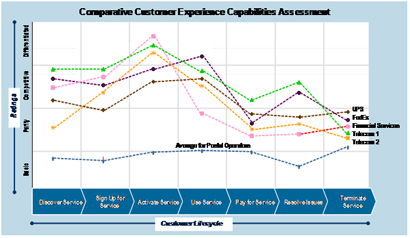
How postal organisations are adopting customer centricity to achieve high performance
While there may be some uncertainty about who first coined the phrase “the customer is king,” there is little doubt that postal organisations are beginning to recognize the vital importance of the customer. Accenture research linking positive customer experience to revenue growth shows that posts must focus on the customer first. Accenture research has shown that one of the biggest differentiators between postal organisations that achieve high performance and their lower performing peers is the emphasis that the high performers put on customer experience and the ability to obtain insights into customers’ thinking. From the perspective of profitable growth, posts that have focused on the customer experience have outperformed over the past five years. In recent research involving more than 23 postal and express organisations, players with strong customer experience agendas had two to three times the revenue growth and a strong, positive return on invested capital when compared to traditionalist postal organisations.
In the past, postal organisations could rely on their monopolistic status to shield them from the need to truly understand customers’ needs. Now, the heat is on to take customer centricity seriously due to diversification, liberalisation and structural changes in the industry. Accenture believes posts need to address three critical operational issues.
First, there is a myth that postal organisations have some areas of their business protected from direct competition through regulation. The reality is that most postal products and services face competition. With an Internet driven electronic climate opening up markets and methods, as well as strong competitors in some categories, there is a substitute for any given product in all customer segments, from individuals to small businesses to large-scale mailers.
Second, there is a fundamental shift occurring in the mail mix that is changing the role of the postal organisation. As the volume of transactional mail has decreased, and direct mail has increased, over the last decade, posts are seeing their role evolve from transportation vehicle to marketing channel.
Finally, there is the knotty issue of the relevance of postal organisations to Generations X and Y, age groups characterised by a preference for social networking, e-mail and instant communications platforms such as Twitter. Will postal organisations be able to maintain their credibility as a key communications and marketing channel in the future? Whilst they view companies that undertake large mailing campaigns as their traditional customers, in fact their customers are all stakeholders in the delivery chain. And large mailers are addressing the need to use Twitter and similar channels, not only to reach vital segments, but also to cut costs.
The case for customer first
So what are the characteristics of the customer experience for posts? Accenture has identified the following dimensions:
| Dimension | Description | Example of potential revenue loss when customer experience is not optimized
|
| Product | Product selection that meets customers’ needs. | Customers who require a full range of mailing and shipping services may look elsewhere if there are “holes” in your organisation’s portfolio i.e.; next day 8am, 3-day service. |
| Access | Access/convenience to products and services, both virtual and physical. | Customers who are unable to obtain same day pick up or undertake transactions online will look for alternatives and limit your share of their wallet. |
| ase of use | Making all transactions and interactions as easy as possible. | Long lines and difficult to navigate websites, as well as inconsistent service and answers across channels, deter customers from continuing to do business with your organisation. |
| Services | Value added services, especially for more sophisticated products. | Limited account setups, reporting and payment options will deter customers from continuing to do business with your organisation. |
| Relationship | Knowing and tracking customer interaction and establishing a rapport and intimacy with customers. | Failure to build a rapport with customers, especially small businesses that typically deal with customer service agents will limit your ability to service them well. |
| Price | Competitively priced products and services. | Every increase in the price of a stamp makes you less competitive in the highly elastic direct mail segment; e-mail becomes increasingly advantageous. In some markets, volume discounts make integrators such as FedEx or DHL as competitive as posts. |
Customer experience is the key to increasing and diversifying revenue. Despite the emphasis that postal organisations are placing on operational efficiencies, such efficiencies often do not address the most critical issue facing them today: profitable revenue growth.
The two primary ways that improving the customer experience drive revenue growth and help postal organisations achieve high performance are:
- Retaining a greater share of wallet from existing customers by helping to ensure the core service is right and capturing additional revenue that may be typically allocated to competitors.
- Meeting unmet customer needs by innovating and launching new products and services focusing on one or more dimensions of the customer experience. Examples include leveraging the proxity and convenience of the retail network, as is the case with Singapore Post and South African Post Office; whilst Poste Italiane has embraced the marketing channel concept by launching a mobile phone service to offer greater options for its consumers and large customers.
State of the market
With a few exceptions, many postal organisations struggle to offer a stellar customer experience. In comparison with other industries such as telecommunications or financial services, the performance of posts is lackluster, as we can see in Figure 1.
Figure 1. Comparative Customer Experience Capabilities Assessment

In a separate piece of research that complemented the 2009 study, Accenture examined the customer experience across all stages, from the moment that services are discovered to the point at which services are terminated. For the majority of postal organisations, the customer experience showed that many customer pain points remained unaddressed and the overall ranking of the customer experience was basic.
Some of the customer pain points identified include: being unable to create a single account across products or open an account online; the absence of a complete range of products and services (this can often drive customers to seek alternatives); limited payment options for pickup and delivery; inconsistent answers and limited product support across channels (retail, online, call centre).
Just as queuing for a cashier has all but been eliminated at t banks, waiting in line at the postal counter is becoming a thing of the past. In the same way that telecommunications and financial institutions have evolved over the past two decades, so must postal organisations expand their traditional approaches in order to meet customer needs and drive profitable growth?
Keeping customers satisfied
So how can posts improve their approach to the customer experience? As a first step conduct an assessment of the current customer experience. How does your organisation currently approach customers? What are your revenue retention and improvement opportunities? Creating an awareness of the current situation, compared with where your organisation thinks it is, and where it aims to be ,is a giant leap forward in achieving transformation goals.
Accenture identified specific capabilities that posts need to improve the customer experience. Successful postal organisations have the ability to:
- Track customer behaviors and satisfaction
- Generate insight from transactional information.
- Create additional revenue opportunities from the insight gleaned.
- Adapt their operating model to focus as much on the customer as on operations.
Working alongside senior postal executives, Accenture has found that postal organisations face several challenges in advancing an agenda focused on the customer experience. First, posts often face regulatory constraints that prevent them from enabling certain aspects of the customer experience, for example, pricing and changes to the characteristics of regulated products. Perhaps more importantly, management teams often persuade themselves not to take action on the basis that such action is contrary to their mandate or regulations. However, this kind of thinking has not prevented Poste Italiane and Correios Brasileiros from changing their operational models and focus on the customer experience. Second, postal organisations do not attract, develop and retain the talent and capabilities needed to better understand customer needs and to manage the customer experience as a strategic differentiator. They must overcome low pay structures, limited “outside-in” recruiting, and the gravitational pull of operations, in order to develop a strong customer-facing organisation.
Customer as king
As many private sector businesses will attest, there is a real correlation between customer experience and new revenue streams. But to fully exploit the opportunity, key internal capabilities need to be in place. Accenture believes that in a highly dynamic and competitive economy, postal organisations that are able to deliver a satisfying customer experience can gain a powerful and sustainable competitive edge, which drives revenue growth across channels and, ultimately, helps the organisation achieve high performance.
If you would like to know more about customer centricity in postal organisations, or read the Accenture High Performance Business research conducted on the postal industry, contact Brian Moran, managing director Accenture’s postal industry group at [email protected] or Andre Pharand, senior manager within Accenture Supply Chain Management service line at [email protected].













